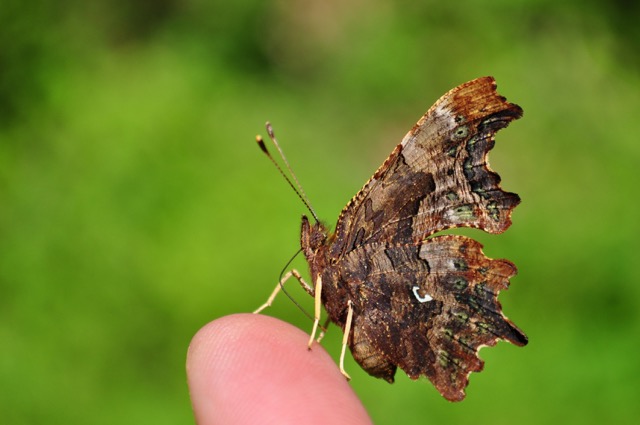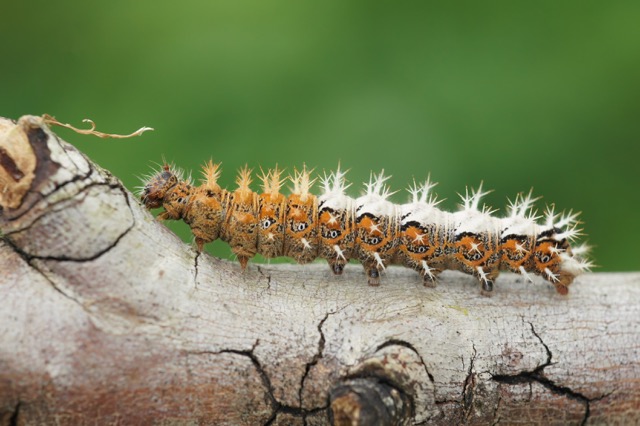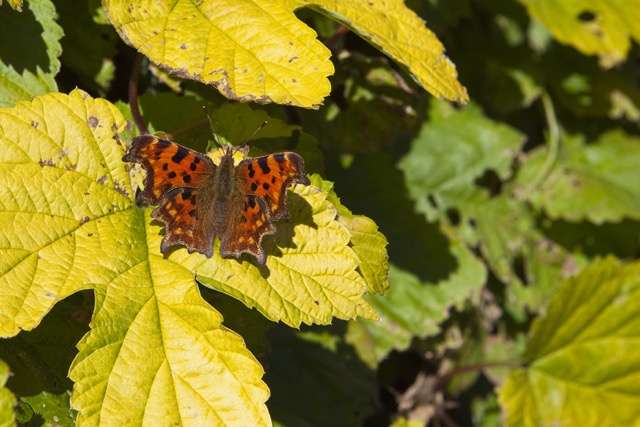
For 2024, our calendar features watercolour illustrations of UK wildlife by Alexia Claire. To go alongside this, we'd like to tell you more about the plants and animals we chose to feature each month. For February 2024 our species of the month is the Comma Butterfly.
How to identify a Comma
The Comma (Polygonia c-album), is a small to medium-sized butterfly that inhabits landscapes of Europe and Asia. As an adult its wings, have a very irregular wing shape with a mottled pattern of earthy browns and oranges. They have distinctive white mark resembling a comma punctuation mark on the underside of its hindwings.
The caterpillars exhibit superb mimicry, resembling bird droppings in their early instars. As they mature, they take on an appearance, with irregular projections along the sides of their bodies. This outline, resembling a piece of a broken twig, contributes to their camouflage in the natural environment.
With the coming of Spring, comma butterflies emerge from their winter hibernation, seeking out nectar-rich blooms and sun-dappled spots to bask. With the arrival of autumn, they enter a state of dormancy, finding refuge in secluded nooks until the warmth of spring reawakens them once again.

Where is the Comma butterfly found?
Comma butterflies and their caterpillars can be found in meadows, gardens, woodland clearings, and other similar environments. These butterflies are known for their adaptability and are observed in a diverse array landscapes, contributing to their widespread distribution.
The specific countries where comma butterflies can be found include parts of Europe, such as the United Kingdom, France, Germany, and Scandinavia. In Asia, their range extends to regions like Russia and parts of the Far East.
What does the Comma butterfly eat?
The caterpillars of comma butterflies rely on a variety of species, but feed primarily feed on stinging nettle (Urtica dioica) leaves. Other food plants for the caterpillars include currants, Elms, Hops and Willow species

Once the comma butterfly reaches its adult stage, it primarily feeds on the nectar of various flowering plants. They have a preference for flowers with ample nectar, and their feeding habits contribute to the pollination of these plants. Common flowers that attract adult comma butterflies include thistles, brambles, and other flowering plants found in meadows and woodland areas. They use their proboscis, a long, tubular mouthpart, to access the nectar from the flowers.
Conservation of the Comma butterfly
During the mid-1800s, the Comma butterfly occupied a limited geographic range in the UK, predominantly confined to the Welsh border counties. The historical scarcity of the Comma butterfly was linked to the decline in cultivation of hops, subsequently limiting the availability of a critical food source for Comma caterpillars.
Fast forward to today, and the Comma butterfly is making a serious comeback. Butterfly Conservation reports a whopping 57% increase in the Comma population since the 1970s1. Once reliant on the specific conditions provided by hop cultivation, the species quickly adapted to the much more widespread Common Nettle.
At the same time, warming temperatures de to climate change have created further favourable conditions for this species. The butterfly's range is expanding northwards at an impressive rate of approximately 10 km per year2. As a result, what was once a rare sight confined to certain regions in England has now become much more widespread, with sightings from Central Scotland now fairly common.

Understanding trends in butterfly populations is important, and not only for species under threat. Adaptable species like the Comma are fantastic indicators of wider environmental impacts, such as climate change. Butterfly Conservation's Big Butterfly Count is a great way for the whole to get involved in Citizen Science.
Citations
(1) Comma (2023) Butterfly Conservation https://butterfly-conservation.org/butterflies/comma
(2) Climate Change and British Butterflies (2022) Butterfly Conservation https://butterfly-conservation.org/news-and-blog/climate-change-and-british-butterflies


